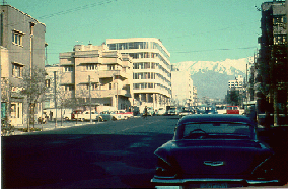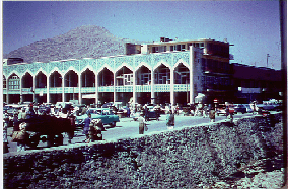
|
Kabul
by
copyright, Iraj Bashiri, 2003 |

|
Kabul
by
copyright, Iraj Bashiri, 2003 |
The city of Kabul, in east central Afghanistan, is the capital of the Islamic Republic of Afghanistan, as well as of the Kabul Province. It is located in a valley between the Asmai and Sherdarwaza mountains and at an elevation of about 1800 m (about 5900 ft). One of the highest capital cities in the World, Kabul is also one of the world's oldest cities with about 3,000 years of history. The city is mentioned in the Rgveda (early Indian scriptures, c. 1500 BC), and was known to Ptolomy, as well as to ancient geographers and mathematicians. Kabul's historical monuments include the tombs of the city's major figures, Zahir al-Din Babur's garden (including his tomb), and the Dar al-Aman Palace.
|
The population is around 1 million people. The Tajiks of Afghanistan form the predominant population group of Kabul; the Pashtuns are a sizeable and important minority in the city. The more recent history of Kabul harks to the time of the conqueror Babur (died in 1530), who chose it as his capital in 1504. Between 1504 and 1738, when it was captured by Nadir Shah of Iran, Kabul served as a major center of Mughal culture. After the death of Nadir Shah in 1747, Kabul was included in the newly-recognized independent Afghan state. As such it became the focus of attention of not only the British Raj, but the Qajars of Persia, and Imperial Russia. Each of these rivals was seeking control of Kabul which, in reality, meant control of the Khyber Pass. In the 1776, Kabul became the capital of Afghanistan, displacing the ancient center of Qandahar. During the 19th century, Kabul was occupied twice (1839-1842 and 1879-1880) by British troops. In 1919, after a third war with the British, Kabul finally gained its total independence from the British Crown. After 1940, it began to grow rapidly both as an industrial center and a center for education for the region. |

|
In the 1960s and 1970s, education, especially at the high school level, grew very rapidly so that Kabul University, which had been founded in 1932, was no longer able to cope with the demand. The Afghan government was forced to seek foreign assistance for its expanding educational programs. As a result, a number of Western nations contributed to the makeup of Afghan education at the time. For instance, the United States agreed to develop the University's Departments of Engineering, Agriculture, and Education, while the French provided funds and personnel for the Departments of Medicine and Law. The Germans took the responsibility for the Departments of Natural Sciences, and the Soviets for the Department of Psychology. Islamic law, a most important aspect of the future developments in Afghanistan, was aided by Egypt.
While these efforts at reconstruction and reform were under way, Afghanistan as a whole was plunged into an unending war with their northern neighbor, the Soviets. From 1979 through February 15, 1989, Kabul was occupied by Soviet troops. The departure of Soviet troops and reduction of American assistance after 1989, plunged the city into chaos. Then, between 1992 and 1996, the city underwent a most disastrous civil war during which over 50,000 Afghans lost their lives. The Taliban takeover of the city between 1996 and 2001 was an even worse time for the Afghans, especially for Afghan women.
 |
During the decade mentioned above, the inhabitants of Kabul suffered the brunt of three wars, one international and two local wars. They carried the brunt of the war with Soviets, the rise and fall of the Mujahidin and the rise and fall of the Taliban fundamentalist groups. Nevertheless, Kabul University continued its educational mission until 1992, when it was closed. After the fall of the Taliban, the university has reopened. But it will take time for the institution to regain the vitality of its recent past. Lack of a campus, students, and competent processors in the town lead the list of needs for the rejuvenation of this most important aspect of Kabul. |
|
The last battle among the Afghans for dominance took place when, in 2001, the Northern Alliance pushed the Taliban fundamentalists out of the leadership positions in the country and, with the help of the United Nations, set up a temporary, and later, a permanent government in Afghanistan. The future of Kabul, thus, depends more on the decisions of the United Nations and the World community than on the people of Kabul. A great deal of reconstruction is required as the city's infrastructures, i. e., roads and traffic systems, telephone system, electricity, water sanitation, renovation of buildings are all in shambles. Kabul's proximity to the Khyber Pass, which separates Afghanistan from Pakistan and India, makes it one of the most important strategic locations in that part of the world. It also makes Kabul a major center of trade and development of light industry. Kabul's industries include several food processing plants, rayon and wool mills, a furniture factory, a foundry, and a marble works. Products manufactured in the city include textiles, processed food, chemicals, and wood products. |
|